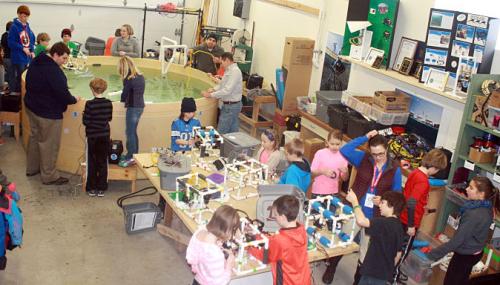Northeast Mich. school could win $10,000 in nationwide STEM competition
Teach for the Planet Challenge features Ella White Elementary project that combines native fish species, underwater robotics and is helping to inspire youth. Online voting could net school first prize.

While some elementary students were busy reading through their textbooks, students at Ella White Elementary school were designing underwater robots, wading rivers with nets, exploring invasive species issues, studying fisheries habitat while out on Lake Huron and collaborating alongside Great Lakes scientists.
Now the students are vying for a $10,000 prize as part of the Teach for the Planet Challenge, a competition to find the most innovative STEM (Science, Technology, Engineering, Math) programs in schools nationwide.
Voters can cast their ballot online for the Ella White project via the Teach for the Planet Challenge voting page. Their environmental STEM project called Engineered Lake Trout Delivery System was selected as a finalist in the grades 3-5 bracket. Winners are selected by popular vote, and voting ends March 11.
The project began thanks to teacher Bob Thompson, whose fifth-graders proudly put forward their student-designed research projects. Through this project, students are raising native lake trout eggs in their classroom, connected with a Lake Huron reef habitat restoration project. With Great Lakes scientists, they are studying Great Lakes ecosystems, fish habitat issues and plan to eventually release the lake trout fry this spring using underwater robots. Applying technology and creative engineering minds, students used a 3-D printer to produce a system (adapting a plastic pop bottle) to release their young lake trout to their underwater reef habitats.
To vote for the Ella White student project, you must first vote on the projects in the K-2nd grade bracket. Another Michigan school, University Yes Academy in Detroit, in the grade K-2 category also boasts early elementary students in the running for their “Planting Detroit Solutions for Pollution” project.

The Makers Space! Alpena Elementary School youth engineer remote operated underwater robots (ROVs), among other engineering projects, to aid in their study of the Thunder Bay watershed. Bob Thompson | Alpena Public Schools
Thompson's class has been a long-term partner with Michigan State University Extension and Michigan Sea Grant through the the Northeast Michigan Great Lakes Stewardship Initiative (GLSI) network, establishing theThunder Bay Watershed Project – where students engage in a variety watershed science and studies. These students:
- Partner with other schools monitoring river health across their watershed by gathering and sharing water quality data.
- Collaborate with US Fish and Wildlife Service and Michigan DNR Fisheries on a native fish species project, inspiring the Lake Trout Delivery System. Along with lake trout, they raise threatened Lake Sturgeon in the classroom creating many community education opportunities – including a Super Sturgeon education poster they recently published with Michigan Sea Grant.
- Engineered and constructed underwater robotics applying this technology toward their watershed studies with NOAA Thunder Bay National Marine Sanctuary and 4-H Youth Programs and Alpena 4-H Robot Factory club.
- Track populations of several aquatic invasive species impacting their watershed, last year partnering as citizen scientists investigating invasive species in local Hubbard Lake where they collected water samples for an Environmental-DNA analysis project at MSU.
No stranger to the national spotlight, teacher Thomson is also a Chevrolet Green Educator Award winner, and his past students have won Disney Planet Challenge competition honors for their environmental stewardship projects. Thomson serves as a leader teacher for the Northeast Michigan GLSI network regionally, contributes to MSU Extension’s youth-STEM initiatives and has been supported by regional Sea Grant Center for Great Lakes Literacy.



 Print
Print Email
Email




